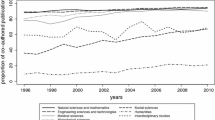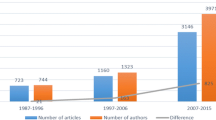Abstract
Several studies exist which use scientific literature for comparing scientific activities (e.g., productivity, and collaboration). In this study, using co-authorship data over the last 40 years, we present the evolutionary dynamics of multi level (i.e., individual, institutional and national) collaboration networks for exploring the emergence of collaborations in the research field of “steel structures”. The collaboration network of scientists in the field has been analyzed using author affiliations extracted from Scopus between 1970 and 2009. We have studied collaboration distribution networks at the micro-, meso- and macro-levels for the 40 years. We compared and analyzed a number of properties of these networks (i.e., density, centrality measures, the giant component and clustering coefficient) for presenting a longitudinal analysis and statistical validation of the evolutionary dynamics of “steel structures” collaboration networks. At all levels, the scientific collaborations network structures were central considering the closeness centralization while betweenness and degree centralization were much lower. In general networks density, connectedness, centralization and clustering coefficient were highest in marco-level and decreasing as the network size grow to the lowest in micro-level. We also find that the average distance between countries about two and institutes five and for authors eight meaning that only about eight steps are necessary to get from one randomly chosen author to another.












Similar content being viewed by others
References
Abbasi, A., & Altmann, J. (2010). A social network system for analyzing publication activities of researchers. Symposium on collective intelligence (COLLIN 2010), Advances in intelligent and soft computing, Springer, Hagen, Germany.
Abbasi, A., & Altmann, J. (2011). On the correlation between research performance and social network analysis measures applied to research collaboration networks. In Proceedings of the 44th annual Hawaii international conference on system sciences. Waikoloa, HI: IEEE. doi:10.1016/j.joi.2011.05.007
Abbasi, A., Altmann, J., & Hossain, L. (2011). Identifying the effects of co-authorship networks on the performance of scholars: A correlation and regression analysis of performance measures and social network analysis measures. Journal of Informetrics.
Abbasi, A., Altmann, J., & Hwang, J. (2010). Evaluating scholars based on their academic collaboration activities: Two indices, the RC-index and the CC-index, for quantifying collaboration activities of researchers and scientific communities. Scientometrics, 83(1), 1–13.
Acedo, F. J., Barroso, C., Casanueva, C., & Galán, J. L. (2006). Co authorship in management and organizational studies: An empirical and network analysis. Journal of Management Studies, 43(5), 957–983.
Barabási, A. L., Jeong, H., Néda, Z., Ravasz, E., Schubert, A., & Vicsek, T. (2002). Evolution of the social network of scientific collaborations. Physica A: Statistical Mechanics and its Applications, 311(3–4), 590–614.
Bavelas, A. (1950). Communication patterns in task-oriented groups. Journal of the Acoustical Society of America, 22, 725–730.
Borgatti, S. (1995). Centrality and AIDS. Connections, 18(1), 112–114.
Borgatti, S., Everett, M., & Freeman, L. (2002). Ucinet for windows: Software for social network analysis (version 6). Harvard, MA: Analytic Technologies.
Freeman, L. C. (1979). Centrality in social networks conceptual clarification. Social Networks, 1(3), 215–239.
Freeman, L. C. (1980). The gatekeeper, pair-dependency and structural centrality. Quality & Quantity, 14(4), 585–592.
Grossman, J. W. (2002). The evolution of the mathematical research collaboration graph. Congressus Numerantium, 158, 201–212.
Jiang, Y. (2008). Locating active actors in the scientific collaboration communities based on interaction topology analyses. Scientometrics, 74(3), 471–482.
Katz, J., & Martin, B. (1997). What is research collaboration? Research Policy, 26(1), 1–18.
Leclerc, M., & Gagné, J. (1994). International scientific cooperation: The continentalization of science. Scientometrics, 31(3), 261–292.
Luukkonen, T., Persson, O., & Sivertsen, G. (1992). Understanding patterns of international scientific collaboration. Science, Technology & Human Values, 17(1), 101.
Luukkonen, T., Tijssen, R., Persson, O., & Sivertsen, G. (1993). The measurement of international scientific collaboration. Scientometrics, 28(1), 15–36.
Melin, G. (2000). Pragmatism and self-organization: Research collaboration on the individual level. Research Policy, 29(1), 31–40.
Melin, G., & Persson, O. (1996). Studying research collaboration using co-authorships. Scientometrics, 36(3), 363–377.
Moody, J. (2004). The structure of a social science collaboration network: Disciplinary cohesion from 1963 to 1999. American Sociological Review, 69(2), 213.
Newman, M. E. J. (2001a). Scientific collaboration networks. I. Network construction and fundamental results. Physical Review E, 64(1), 16131.
Newman, M. E. J. (2001b). Scientific collaboration networks. II. Shortest paths, weighted networks, and centrality. Physical Review E, 64(1), 16132.
Newman, M. E. J. (2001c). The structure of scientific collaboration networks. Proceedings of the National Academy of Sciences of the USA, 98(2), 404.
Newman, M. E. J. (2004). Coauthorship networks and patterns of scientific collaboration. Proceedings of the National Academy of Sciences of the USA, 101(Suppl 1), 5200.
Owen-Smith, J., Riccaboni, M., Pammolli, F., & Powell, W. (2002). A comparison of US and European university-industry relations in the life sciences. Management Science, 48(1), 24–43.
Sabidussi, G. (1966). The centrality index of a graph. Psychometrika, 31(4), 581–603.
Scott, J. (1991). Social network analysis: A handbook. London: Sage.
Sonnenwald, D. (2007). Scientific collaboration: A synthesis of challenges and strategies. Annual Review of Information Science and Technology, 41, 643–681.
Suresh, V., Raghupathy, N., Shekar, B., & Madhavan, C. E. (2007). Discovering mentorship information from author collaboration networks. Discovery Science, 4755, 197–208.
US Office of Science & Technology Policy (2000). Examples of international scientific collaboration and the benefits to society. Retrieved June 14, 2005 from http://clinton4.nara.gov/WH/EOP/OSTP/html/00426_7.html.
Wagner, C. S., & Leydesdorff, L. (2005). Network structure, self-organization, and the growth of international collaboration in science. Research Policy, 34(10), 1608–1618.
Watts, D., & Strogatz, S. (1998). Collective dynamics of ‘small-world’networks. Nature, 393(6684), 440–442.
Acknowledgment
The authors appreciate the anonymous reviewers for their positive and useful comments on the early drafts of this paper.
Author information
Authors and Affiliations
Corresponding author
Rights and permissions
About this article
Cite this article
Abbasi, A., Hossain, L., Uddin, S. et al. Evolutionary dynamics of scientific collaboration networks: multi-levels and cross-time analysis. Scientometrics 89, 687–710 (2011). https://doi.org/10.1007/s11192-011-0463-1
Received:
Published:
Issue Date:
DOI: https://doi.org/10.1007/s11192-011-0463-1




